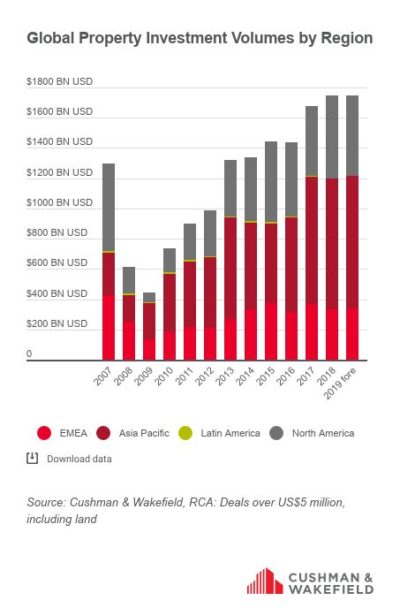Global real estate transaction volumes increased by 4 percent year-o-year, reached a record high of US$1.75 trillion in 2018 from US$1.68 trillion in 2017 and are forecast to match this trend in 2019, according to new data from Cushman & Wakefield.
The firm forecasts record levels to be maintained in 2019, in the region of US$1.75 trillion, as investors target a wider range of markets to find opportunity, and more sellers come forward as real estate strategies adjust to evolving monetary policy, geopolitical tensions and structural change.
The report states that pricing is expected to edge ahead, however this will be driven by stable yields and steady rental growth for the best assets rather than yield compression which has typified recent years.
Report author David Hutchings, Cushman & Wakefield’s Head of Investment Strategy EMEA Capital Markets, explains: “The economic environment is weaker than expected just a few months ago but so too is the inflation outlook on a global basis. As a result, while risk is up, the day of reckoning on interest rates for corporates and investors has again been delayed. The coming year is therefore set to see a further extension of the property cycle, offering investors another chance to get their portfolio into shape ahead of a period of slower growth.
“With a stable, contracted income and exposure to growth and inflation, real estate continues to be incredibly attractive and demand remains strong for the right product. However, defining the right product has become ever harder as powerful, market-moving occupier strategies are reshaped by e-commerce, social and business change, low growth and affordability constraints.”
” North America was the only capital source to increase overall commercial real estate (CRE) allocations.. ”
North America rebounded from 2017’s volume decline to outperform in 2018, both as a target and a source of real estate investment with late-cycle tax stimulus in the US helping to offset higher borrowing costs. Although all global regions were active buyers last year, North America was the only capital source to increase overall commercial real estate (CRE) allocations compared to 2017, with volumes increasing 17% y/y to US$546 billion. Investment volumes in North America are predicted to reach US$530.7 billion in 2019. This is a 3% decrease y/y but a reflection of the regions’ mature position in the property cycle putting upward pressure on yields and follows an exceptional 2018.
SEE ALSO : UK commercial real estate investment volumes reach £62.1bn in 2018
CRE allocations in Europe, Middle East and Africa (EMEA) and Asia-Pacific (APAC) fell 2% and 1% respectively in 2018, the latter largely due to fewer global purchases over the year. European and Asian institutions are, however, increasing allocations to real estate, and both regions are also likely to see more inbound cross border demand, notably Europe in the short-term, and Asia in the medium-term as investors follow demographic trends.
EMEA investment volumes recorded US$331 billion in 2018, a 10.8% y/y fall owing to a pull-back from both global and domestic sources and the conclusion of some large portfolio deals. European retail documented its third consecutive year of decline (US$56 billion), with lower volumes across much of the region. Industrial and office transactions also contracted by -24.7% and -9.7% y/y respectively but was likely down to a shortage of investible stock. EMEA investment volumes in 2019, are predicted to reach US$339.2 billion, a 2.5% increase on 2018 levels, driven by increased demand across a growing range of tier 2 cities and new sectors.

”The USA and Canada were the top sources of cross border investment capital ..”
Carlo Barel di Sant’Albano, Chief Executive of Cushman & Wakefield’s Global Capital Markets & Investor Services, said: “International capital flows are becoming yet more dynamic, increasingly cross border and more about balancing quality with quantity – this will be true whether you are referring to stock, yields, talent or living standards.
“An abundance of capital will continue to drive the market and sustain pricing in 2019, but structural forces, such as e-commerce, will be driving areas of outperformance even as the cycle slows. Hence there is a real need to look beyond market averages to see the detail of the local market, the deal, the vendor, the lender and above all, the user.”
SEE ALSO : Singapore largest source of Asian capital in global real estate
While the USA was the top target for global CRE investment (US$45 billion), EMEA has retained its historical position as the most sought-after destination for international capital, with the most cities among the top ten cross border investment targets and attracting 53% (US$88 billion) of global investment.
The USA and Canada were the top sources of cross border investment capital, together accounting for 40% of all non-domestic investment flows last year (US$125 billion). German capital rounded out the top three at US$26 billion. Interestingly, despite UK investment managers strengthening their continental portfolios, French cross-border investment outflows outpaced the UK for the first time on record. The make-up of cross border investment from Asia Pacific likewise altered, with mainland China and Hong Kong dropping back but Singapore and South Korea moving up the rankings.





















